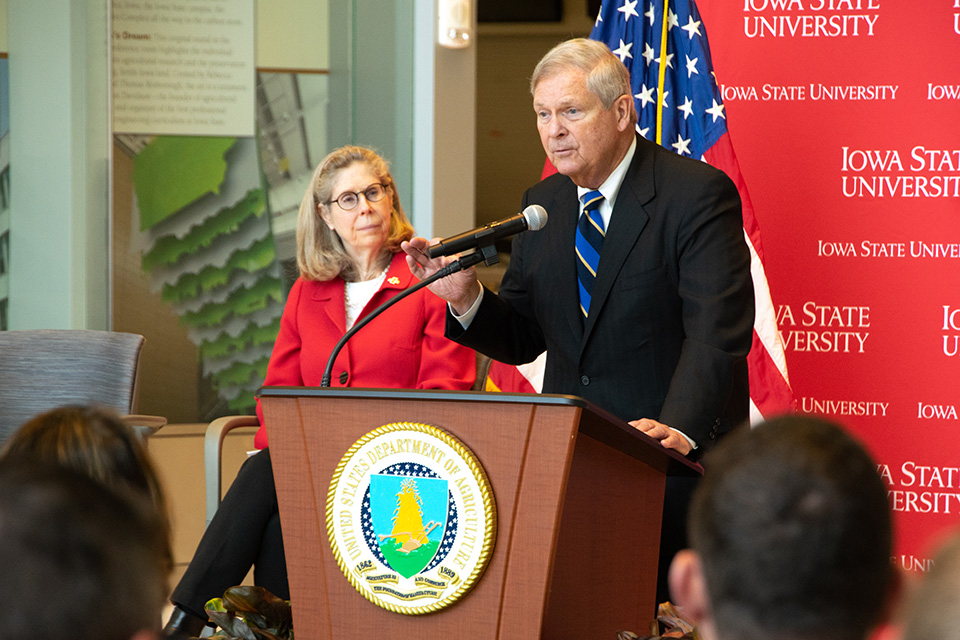
(Photo: Bethany Baratta/Iowa Soybean Association)
Awarded grants seek to build on intercropping research efforts
July 13, 2023 | Bethany Baratta
Awarded grants seek to build on intercropping research efforts
Collaboration and cooperation were the words of the day at Iowa State University’s Sukup Hall.
The Iowa Soybean Association (ISA) in partnership with the Iowa Corn Growers Association (ICGA), received a $910,000 grant through the U.S. Department of Agriculture’s (USDA) Conservation Innovation Grants (CIG) program.
The Cropping Systems Approach to Increase Farmer Profitability, Reduce Nutrient Losses and Improve Soil Health in Soybean and Corn Production will propel conservation and water quality efforts forward in Iowa.
“We know that Iowa farmers are great stewards of the land and the best in the world at what they do,” said ISA Research Center for Farming Innovation Director of Research Joe McClure. “We also know that Iowa’s ag industry can get better, become more efficient and more sustainable without sacrificing production for a growing world. This conservation innovation grant project will research a novel cropping system to do this.”
Work will begin immediately to initiate farm recruitment for fall field implementation.
“This research will be focused on combining the best practices that have been identified independently into a holistic system on corn and soy fields by leveraging the farmer networks, the technical expertise and the resources of various organizations to conduct innovative and practical field research,” McClure says.
ISA and ICGA will deliver on three key objectives on this project:
- Characterize profitability and natural resource outcomes for improved cropping systems via on-farm research.
- Develop new insight on current and improved cropping systems in terms of economics, natural resource conservation, and yield stability via crop modeling and statistical analysis.
- Accelerate adoption of improved cropping systems via participatory learning, enablement of conservation agronomists embedded in ag retail businesses and ongoing outreach.
“This project will attempt to identify and validate a cropping system that delivers reduced erosion, increased nitrogen sequestration, improved water quality, reduced inputs, and increased profitability in a changing environment where resiliency is needed,” McClure says.

Understanding intercropping opportunities and apprehension
At the same event today, ISA was announced as a sub-awardee in a $539,000 grant awarded to Iowa State University (ISU).
Through on-farm trials coordinated with ISA farmer members, the project will demonstrate the advantages of a relay intercropping system to maintain or enhance productivity and profitability while improving soil health and increasing nutrient reductions.
This proposed demonstration project in 2024, 2025 and 2026, will take a multi-faceted approach to evaluating a relay intercropping system that integrates cereal grains (either winter wheat or cereal rye) into corn and soybean production systems.
A diverse intercropping system will add cropping system resiliency and promote a more diverse and stable community of soil organisms—from microbes to earthworms—while suppressing pathogens and crop pests and benefitting nutrient cycling and soil structure, says ISA research agronomist Alex Schaffer.
“The practice is beneficial to the farmer because it is a rare opportunity to show immediate return on investment in a conservation practice,” he says.
Research done by ISA finds the practice can be more profitable than mono-cropped soybeans. The next step is identifying best management practices to protect soybean yield in the system.
“We are hoping our work will give farmers the information necessary for more widespread adoption of the practice leading to more profitability and sustainability of Iowa farmers,” Schaffer says.
The project will be led by Dr. Jacqueline Comito, director of ISU’s Iowa Learning Farms. As an anthropologist, she has extensive experience in evaluation and qualitative research methods.
“Relay intercropping addition of a third cash crop could be a game changer in Iowa in terms of diversifying cropping systems,” Comito says. “If farm profitability can be improved with relay intercropping, this system can be beneficial to farms of all sizes and types, particularly beneficial to historically underserved farmers such as beginning and limited resource farmers seeking to maximize profit on each acre.”
Learning through research and outreach
Productivity and profitability are vital to the economic success of farmers, says ISA President Randy Miller. And seeing is believing.
“Until you have some of this research to see some of the benefits or disadvantages of adding a third crop, farmers will be reluctant,” says Miller, who farms near Lacona. “But if you can prove that it will be beneficial and doesn’t negatively impact them economically, farmers will adopt the practices. But somebody has to step out and try some of these practices.”
Miller says understanding the practice can help build more resilient cropping systems in the state on farms of all sizes.
“In the back of any farmer’s mind you wonder, ‘what are my neighbors thinking?’ If you know that it works, it’s one thing to take a chance and do it,” he says. “If you’re just trying it, you’re not going to try it on a very big scale, or where the neighbors can see it. This project—through its on-farm research and social understanding—should help expand these practices in the state.”
Back